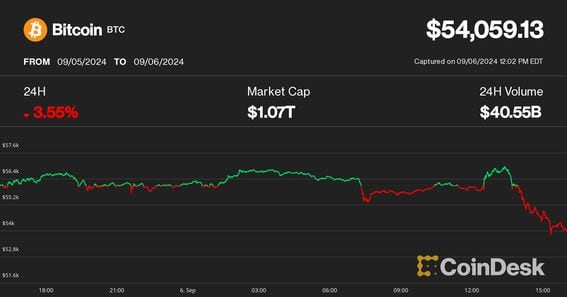- The broad-market CoinDesk 20 index was down 3% over the past 24 hours, with BTC, ETH, XRP, ADA posting declines of as much as 4%.
- Fed governor Waller said he will advocate for “front-loading rate cuts if that is appropriate.”
- A smaller, 25 basis-point cut would be more beneficial for asset prices, Fundstrat’s Sean Farrell noted.
The brief rally in the cryptocurrency markets following Friday’s U.S. jobs report quickly reversed in volatile trading, sending bitcoin (BTC), the largest cryptocurrency, to its lowest in a month.
Bitcoin (BTC) jumped to $57,000 following the report, only to erase the gain and tumble below $54,000 to the lowest since Aug. 5. It is down nearly 3% over the past 24 hours. Major altcoins also slid. Ether (ETH), solana (SOL), Ripple’s XRP (XRP) and cardano (ADA) all posted 2%-4% losses over the same period. The CoinDesk 20 Index was down 2.7%.
The price swing triggered nearly $50 million liquidations in just one hour on crypto derivatives markets as the volatility caught leveraged traders off-guard, predominantly longs betting on a continued price advance, CoinGlass data shows. The more than $3,000 spread between the day’s high and low was the widest since Aug. 28.
Key U.S. equity indexes also turned lower early in their trading sessions. The Nasdaq Composite Index fell 2.5% and the broad-based S&P 500 Index lost 1.6% by midday.
Eyes on Fed rate cuts
The widely anticipated U.S. nonfarm payrolls report showed the world’s largest economy added 142,000 jobs in August, slightly fewer than analyst forecasts, while the lower unemployment rate fell to 4.2% from July’s 4.3%.
The release left market watchers contemplating the Federal Reserve’s pace to lower interest rates, which it’s expected to do later this month. Most recently, traders assigned a probability of more than 70% to a 25 basis-point cut and almost 30% for a larger, 50 bps cut at the Federal Open Market Committee meeting on Sept. 18, according to the CME FedWatch Tool.
Later in the morning, Fed Governor Christopher Waller said in a speech at Notre Dame University that the “time has come” to lower interest rates and he will advocate for “front-loading rate cuts if that is appropriate.”
Some observers argued that a smaller cut would be more beneficial for risk assets, as a 50 bps cut might signal that the Fed is increasingly concerned about the U.S. economy falling into a recession.
“Ultimately, the nature of the cut (bullish or bearish) depends on economic data and Fed commentary, but all things being equal I still view 25 bps as better for asset prices than 50 bps,” said Sean Farrell, digital asset research head at Fundstrat.
UPDATE (Sep. 6, 16:05 UTC): Adds context on U.S. jobs report, Fed Governor Waller’s speech, analyst comment.
Edited by Stephen Alpher and Sheldon Reback.






